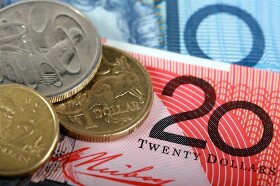
The Australian dollar was soft today, falling against the euro and the Japanese yen for the first time after six sessions of gains in a row. Market analysts pointed at China’s slowing producer inflation as the most likely culprit in the currency’s decline.
The Reserve Bank of Australia released its Monetary Policy Statement today. The central bank upgraded its economic projections. The outlook for growth of gross domestic product for 2018 was upgraded from 3.25% to 3.5%. The forecast for consumer inflation in 2018 got a positive revision from 1.75% to 2%. The forecasts for 2019 remained unchanged at 3.25% and 2.25% for GDP and inflation respectively. The outlook for the unemployment rate was revised from 5.5% to 5% in 2018 and from 5.25% to 5% in 2019.
As a result, the RBA anticipate monetary tightening sometime in the future:
The Board is expecting further progress in reducing unemployment and ensuring inflation is consistent with the target. If that progress is made, higher interest rates are likely to be appropriate at some point.
Yet in the near future, the central bank anticipate monetary policy to stay unchanged:
However, given the expected gradual nature of that progress, the Board does not see a strong case to adjust the cash rate in the near term.
Released separately by the Australian Bureau of Statistics, the seasonally adjusted number of home loans fell 1.0% in September from August, in line with market expectations. The indicator dropped 2.2% in the previous month.
AUD/USD declined from 0.7256 to 0.7241 as of 11:16 GMT today. AUD/JPY dropped from 82.76 to 82.43. EUR/AUD edged up from 1.5656 to 1.5670 after falling to the session low of 1.5635 earlier.
If you have any questions, comments or opinions regarding the Australian Dollar,
feel free to post them using the commentary form below.